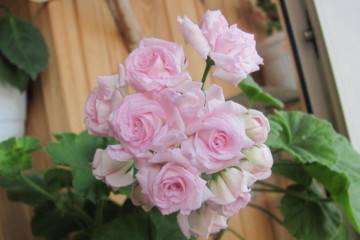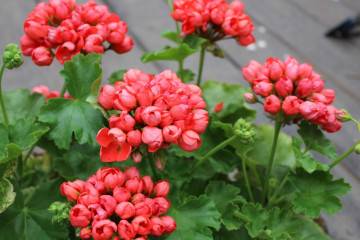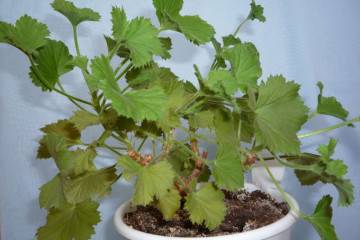Pelargonium Pac Viva Rosita
Content:
The variety of pelargonium varieties allows every gardener to choose the most suitable one. There are varieties of culture that are distinguished by excellent flowering, for which they are especially popular. One of these flowers is Pac Viva Rosita pelargonium.
Pelargonium PAK Viva - what are these flowers
Pelargonium Pak Viva is very common in houses and apartments. Plants of this variety do not require special care, and during the flowering period they very decoratively decorate the premises with their appearance.
For the first time, PAK Viva was received in Sweden. After some time, breeders presented it at a European exhibition, where the plant received a lot of positive reviews. In 2012, a similar pelargonium appeared in Russia and also quickly gained popularity.
The bush is compact in size. The flower is not ampelous, all branches are located close to each other. The leaves are green, rather dense to the touch. It grows rather quickly in a room with good lighting.
Terry petals on the surface. The number of flowers in one inflorescence can be up to 30 pieces. The bud formation process takes quite a long time. However, when they bloom, flowering can last for about a couple of weeks. In some cases, a little longer.
Varieties of indoor plants with names, what they look like
There are several varieties of PAK Viva. They have some differences, but they are all popular.
Caroline
The variety PAK Viva Karolina is distinguished by its lilac-white color of petals in densely growing flowers.
They are terry to the touch, up to five flowers are present on one shoot. The leaves are dark green in color, rather wide. It blooms for a long time and abundantly.
Madeleine
Pelargonium PAK Vita Madeline is distinguished by long flowering and compact bush. The leaves are green, but not as wide as Carolina's.
Madeleine's petals are often white, but with prolonged exposure to light, a pinkish tint may appear.
Rosita
The variety is distinguished by many bright pink flowers. The leaves are green, but not too warm.
The flowering period is just over two weeks. Up to 6 buds grow in the inflorescence.
How to grow Pac Viva Rosita and take care of the flower
Pelargonium Rosita is an unpretentious plant. However, it is recommended to purchase not a full-fledged flower, but its stalk. Caring for him does not require serious effort and will not cause big problems.
Illumination and temperature conditions
Pelargonium Viva Rosita loves partial shade, unlike many other species. It is better to leave the pot in the east or west of the room. Direct sunlight is dangerous for the plant; burns may occur on the leaves and flowers.
Culture loves warmth. The most suitable temperature is considered to be up to 25 degrees. In the warm season, it is recommended to take the container out to fresh air.
Watering rules and humidity
Viva Rosita variety does not require frequent watering. It is important to ensure that the ground does not remain dry for a long time. The pot should have drainage holes so that excess water can drain through them.
It is best to water the crop through the tray. This moisture will be sufficient for the root system. It is recommended to refuse irrigation from above. It is also not recommended to spray the flower, it is permissible to do this only if the air in the room is too dry.
Air humidity equal to 60-65% will be optimal for pelargonium to bloom for a long time and abundantly, as well as develop well. At the same time, it is recommended to ventilate the room periodically. This will help prevent the development of diseases.
Top dressing and soil quality
The soil for planting can be purchased ready-made. It is worth paying attention to the fact that the acidity should be neutral. The soil is independently prepared from turf, peat and river sand in a concentration of 2/1/1.
It is recommended to periodically loosen the soil. This saturates it with oxygen and allows excess moisture to leave faster.
Pelargonium feeding PAK Viva Rosita is carried out from spring to autumn during the period of active growth and development of the flower. It is recommended to use special complex fertilizers that are suitable for geraniums and pelargoniums. The frequency is - 1 time in 2 weeks.
Flower container size
For the first planting, choose a medium-sized pot. A very large capacity will not allow the plant to bloom - it will increase the total mass.
Pruning and replanting
To form a compact and beautiful bush, they must be pruned. The bush is heavily pruned in February - a similar action stimulates the growth of new shoots and leaves. As necessary, the procedure is repeated - to form and remove damaged or diseased shoots. They also pinch the upper and side branches.
Features of flowering plants
The PAK Viva Rosita variety does not bloom all the time, the rest period alternates with the period of activity.
A period of activity and rest
From late autumn to spring, the plant is dormant. At this time, it is better to transfer it to a darker place and leave it at a temperature of +15 degrees.
With the onset of spring, all processes in culture begin to intensify. The flower is again rearranged to diffused light. The budding period lasts about a couple of weeks.
Types and shape of flowers
There are many petals on the flowers. There are several flowers in an inflorescence at the same time, but they are located so that everything can be seen.
The buds are strong, the peduncles are dense.
The process of reproduction of pelargonium by cuttings
Viva Rosita pelargonium can be propagated in several ways - by seeds or cuttings. It is better to carry out the procedure from February to March or from July to August.
The process is carried out as follows:
- A process about 7 cm long is cut off from an adult plant. At least 3 leaves must be present on it.
- The cuttings are slightly dried and placed in a container with prepared soil.
- Water over the edge of the pot.
- After a couple of weeks, rooting will occur.
- If you wish, you can place the scion in a glass of water and wait until it has roots.
Growing problems, diseases and pests
Most plant problems arise from improper care. The culture is affected by various diseases:
- Puccinia fungus. The disease is characterized by the presence of red spots on the leaves. In case of severe damage, the flower may die.
- Blackleg.Shoots and small shoots suffer when planted with seeds. The presence of characteristic blackening at the base of the trunk is noted.
- Gray rot. Occurs due to cool temperatures. The sign is the presence of plaque on the leaves and shoots.
- Nematode. The disease affects the root system. Unfortunately, in this case it will not be possible to save the plant.
The danger to pelargonium is posed by such pests as aphids, whiteflies, and various caterpillars.
How to deal with them
Special products that can be purchased in the store will help to cope with diseases and pests. The drugs are diluted and used according to the instructions. The main advice is to follow the rules of care.
The flower is loved by many collectors because of its many beautiful flowers of bright colors. With proper care, the culture will delight you with an attractive appearance and rapid growth. For prevention, it is recommended to carry out regular treatments against pests and diseases, if necessary, use fertilizers.




















